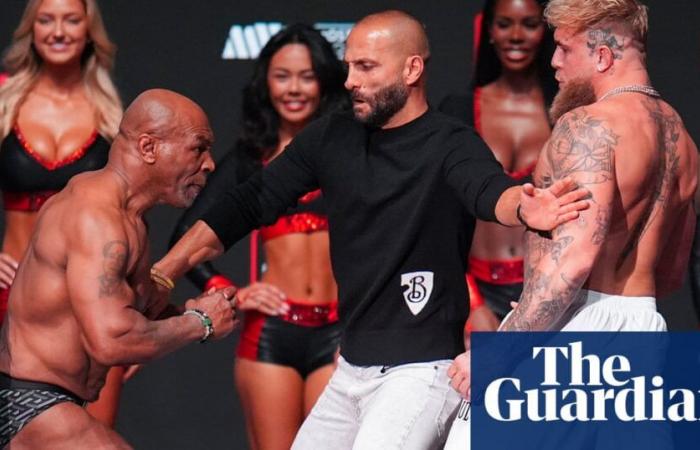Mike Tyson is returning to professional boxing for the first time in nearly two decades on Friday night in Texas. The 58-year-old former undisputed heavyweight champion is fighting YouTuber-turned-boxer Jake Paul in a made-for-Netflix showdown expected to draw a global audience of around 300m viewers.
But is that all you really need to know? What about the rules, how much they’re getting paid and the *checks notes* 31-year age difference. Read on for all the answers …
Where and when is the fight?
The seven-fight card is being held at the 80,000-capacity AT&T Stadium, the $1.2bn home of the NFL’s Cowboys in Arlington, about 20 miles west of Dallas. It’s hard to pin down an exact time for the main event, but Paul and Tyson will not make their entrances before 11pm ET (4am GMT).
How much are tickets?
A robust live gate is expected but there were plenty of tickets available at press time with the cheapest starting at $67 plus fees. Higher rollers can purchase something called the MVP Owner’s Experience that will seat two people less than six feet from ringside in premium leather chairs. Also included: eight additional tickets in the first two rows, a pre-fight locker room visit with Tyson and Paul, a chance to be onstage during the weigh-in, autographed gloves from both fighters, in addition to a personal concierge and security detail throughout the week, all for the princely sum of $2m (£1.58m). And you thought egg-flation was bad.
Where can I watch Paul v Tyson?
The broadcast will stream live globally on Netflix starting at 8pm ET (1am GMT) at no additional cost to subscribers. There will be three televised preliminary fights, including Katie Taylor and Amanda Serrano in a hotly anticipated rematch of their 2022 classic, leading up to the main event. The stream will feature options for live commentary in English, Spanish, Brazilian Portuguese, French and German.
The first three undercard bouts not carried by the Netflix stream will be available free on Most Valuable Promotions’ YouTube, Netflix Sports YouTube and Tudum starting at 5.30pm ET (10.30pm GMT).
Why Netflix?
In a media landscape where TV ratings are falling off across the board, live sports continue to buck the trend. That’s caught the attention of media and tech giants like Amazon (who bought into the NFL) and Apple (who bought Messi), among other billion-dollar bets on sports programming as a driver for subscriptions. Paul v Tyson will mark Netflix’s third foray into live sports after last year’s The Netflix Cup (a golf pro-am with F1 drivers) and March’s The Netflix Slam (a tennis exhibition between Carlos Alcaraz and Rafael Nadal in Las Vegas).
When you consider that Netflix reported 282.7m worldwide subscribers as of last year’s third quarter, and the enormous popularity of Paul and Tyson with divergent age demographics, and the vanishingly low cost relative to usual boxing pay-per-view events (typically $80 in the US), it’s practically guaranteed to be the most-watched fight in years, if not ever.
Why is this fight happening?
The 27-year-old Paul, who has managed to develop into a competent boxer since taking up the sport and turning professional in 2020, winning 10 of 11 bouts against mostly faded MMA fighters and fellow YouTubers, insists it’s another step toward his quixotic goal of winning a world title, saying: “My sights are set on becoming a world champion, and now I have a chance to prove myself against the greatest heavyweight champion ever, the baddest man on the planet and the most dangerous boxer of all time.”
True as that may be, the short money is no small incentive. Paul closed a lucrative deal with Netflix last November to stream one of his upcoming fights before Tyson was even in the frame. The interest (and money) only ballooned with the addition of the former heavyweight champion, who had not fought in an official bout since quitting on his stool after six rounds against Irish journeyman Kevin McBride in June 2005.
What are the rules for the fight?
Unlike many of the similar novelty bouts throughout boxing history, the fight between Paul and Tyson is not an exhibition. Despite concerns over the fighters’ three-decade age difference, along with Tyson’s inactivity and track record of health issues, the Texas Department of Licensing and Regulation (TDLR) determined the former champion’s physical condition met the criteria for the fight to be officially sanctioned. That means there will be three judges at ringside, an official winner will be declared and the result will count on their records. (It also means that sportsbooks can taking betting action on it, although at least six US states have deemed the event too untraditional to allow wagering.)
The Texas commission has taken some precautions. The fight will be scheduled for eight rounds instead of the typical 10 or 12, with two-minute rounds instead of the customary three. Tyson and Paul will also use 14oz gloves instead of the usual 10oz in order to lessen the power of the punches.
How much are they getting paid?
The TDLR denied a request from the Guardian under the Texas Public Information Act (PIA) regarding the purse information. But it has been reported that Paul will earn $40m (£31.6m) for Friday’s event while Tyson is said to be making $20m (£15.8m). Taylor will reportedly bring in $6.1m (£4.8m) for her co-feature rematch with Serrano, whose takehome is thought to be around $8m (£6.3m). That’s an extraordinary come-up for the Nuyorican seven-weight champion, who once was paid $1,500 for a world title defense.
Paul didn’t shy away from his earning power at Wednesday’s final press conference when he sneered at undercard fighter Bruce Carrington, a Brooklyn featherweight who’d doubted his chances: “The time I spend taking a shit is how much you make in your whole life, buddy. Shut the fuck up.” Nice.
Should we be worried?
Honestly, maybe! The 31-year age gap between the fighters is thought to be the largest in the history of professional boxing, eclipsing the 24 years that separated Archie Moore, who was 49, and Mike DiBiase, who was 25, when they met as light heavyweights in 1963. While Tyson continues to trade on his Baddest Man on the Planet image, the reality is he’s a 58-year-old man with a history of health issues who lost 26lbs in May after an ulcer flare-up that left him throwing up blood and defecating tar, prompting the postponement of the fight from July to November. He’s admitted to sciatica outbreaks that have left him unable to talk and was photographed getting pushed in a wheelchair and using a walking stick at Miami International Airport two years ago. Several other states wouldn’t sanction this bout.
Boxers don’t have an old-timers’ day for a reason. There’s a danger at hand any time a fighter climbs through the ropes into the prizering, the only venue in society, with the exception of war, where a person can be killed but not legally murdered. Eddie Hearn, the Matchroom Sport chairman who promotes Taylor, told BBC Sport last month that he will be at ringside to support his champion but will leave immediately after because he doesn’t want to endorse a main event with a fighter of Tyson’s advanced age.
“The reality is that 20 years ago when Mike Tyson retired from the sport he was shot, completely finished,” Hearn said. “If I was Jake Paul I’d just feel a little bit embarrassed to be honest with you. … This is dangerous, irresponsible and, in my opinion, disrespectful to the sport of boxing.”
Who else is fighting on the card?
Hearn isn’t alone in calling it a circus. But with two world title fights on the TV undercard, there’s plenty of value on offer for viewers who aren’t keen on watching two men with more than 30 years between them exchange blows. The order of play is as follows:
The best fight on the card by some distance is Taylor’s rematch with Serrano in defense of all four major title belts at 140lbs. Their first encounter before a sold-out Madison Square Garden two years ago was a contest of extreme physical and psychological intensity that somehow exceeded the breathless hype that preceded it. My heart was pounding so much I had a headache. If Friday night’s second installment matches it for drama, don’t be surprised if they close out the trilogy with a third before 90,000 at Croke Park.
Good for boxing? Or death knell for a dying sport?
Boxing is a sport that has always existed on the precipice of extinction, from the backlash to the English bare-knuckle fights of the 1700s to the mob corruption of the mid-20th century to the renewed abolition movement of the 1980s, often led by white middle-class reformers disconnected from the countless impoverished and disenfranchised youth, mainly Black and Hispanic, it’s saved. We couldn’t be rid of it if we tried.
But does influencer boxing diminish the craft? Our Sean Ingle spoke with Adam Kelly, the president of media of the global sports rights agency IMG, who predicts Friday’s event “will be one of the biggest fights there’s ever been broadcast”. His message to purists? “These fights have encouraged new fans, and led to a fresh wave of interest in boxing. If boxing only appeals to a hardcore fan base, with technical fights, eventually it will die. Because its audiences will age, and then they’ll die. You have to be constantly looking to build your audience. And that means making a product that specifically appeals to people who are not your current fans. Unless you’re doing that, you’re on a shrinking iceberg.”
Translation: if it’s breaking through today’s crowded entertainment marketplace and getting eyeballs in front of boxing, it can only be a net positive for the sport.
Who will win Paul v Tyson?
Even after Thursday’s weigh-in slap, those expecting the type of primal destruction Tyson built his brand on in the 80s and 90s are bound to come away disappointed. And for anyone who believes Tyson’s pride will motivate him against an opponent he would have vaporized in his prime, there may be a hint buried in his sitdown with Rosie Perez for Interview Magazine published Tuesday: “What do I care about my legacy? I never knew what a legacy was and people started throwing that word around so loosely. A legacy sounds like ego to me. I’m going to be dead soon. Who cares what somebody is going to think about me when I’m dead?”
The Texas commission’s sturdy guardrails (shorter rounds, shorter length, heavier gloves) make it far more likely that we’ll get what’s known in tennis as a hit-and-giggle: a polite 16-minute sparring session between business partners laughing all the way to the bank. But no one truly knows, which makes it more interesting than it ever deserves to be.






